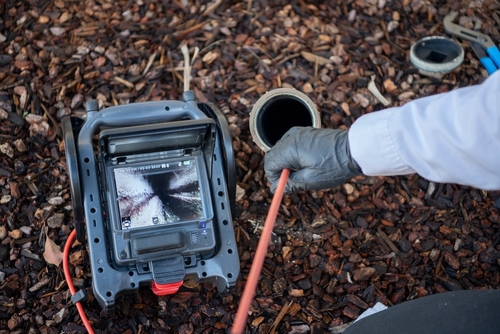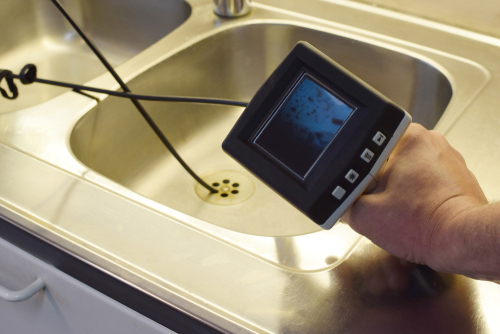July 3, 2025
What Can a Sewer Camera Really See? Common Issues Detected
If you’ve ever had a plumber visit and use a cable with a small camera to inspect your drain, you’ve seen a sewer line camera inspection in action. Sure, it’s an advanced method, but it’s also one of the most straightforward and effective tools available in Chula Vista and nearby areas. It is a good way of figuring out what’s going on inside your pipes without digging up your yard or tearing open walls.
If your drains are backing up, your toilets are slow, or you’re buying a house and want to avoid surprise plumbing costs, this kind of inspection can reveal a lot—roots, cracks, corrosion, even lost toys (yep, that happens). But not everything is visible, and not every video is easy to understand if you don’t know what to look for. Read on to demystify what’s really happening under your home.
What to look for in a sewer camera inspection video?

If you’ve scheduled a sewer line inspection and received the video footage, it can feel a bit like watching a dark, damp horror film. But don’t worry, there are clear indicators to focus on.
Here’s what professionals (and homeowners) should look for:
1. Blockages
Tree roots, grease, wipes, or foreign objects often show up as visible obstructions. You’ll see material protruding into the pipe or water backing up behind it.
2. Cracks or Fractures
Camera footage can reveal visible breaks in the pipe walls, often from soil movement, aging materials, or external pressure (like vehicle traffic above the line).
3. Corrosion
Older cast iron pipes, for example, will show signs of scaling and rust buildup. You’ll often see flakes, rough texture, or narrowing of the pipe interior.
4. Offset or Collapsed Pipes
If a section of pipe has shifted or sunk, you may notice abrupt changes in the pipe alignment or sections where the camera can’t pass.
5. Standing Water or Slow Drainage
If water pools without flowing away, the slope of the pipe may be incorrect, or there might be a sag known as a “belly.” This shows up clearly in the video as slow-moving or stagnant water.
6. Unusual Pipe Materials or Connections
Sometimes DIY repairs or outdated systems show up as mismatched materials or poorly sealed joints, which can lead to future problems.
How far can a sewer camera go?
Sewer cameras can travel surprisingly far, up to 330 feet (100 meters) in most professional-grade systems. However, this distance depends on:
- Type of cable: Push cameras (manually pushed through the pipe) usually reach 100–200 feet. Motorized crawlers can go farther.
- Pipe conditions: Heavy blockages, collapsed lines, or sharp turns can reduce how far the camera gets.
- Entry point: Accessing from a cleanout, roof vent, or toilet drain affects how far you can inspect in one go.
A good rule of thumb: residential inspections typically cover the full distance from the house to the street connection, assuming no major obstructions.
What a sewer camera inspection can’t do?
While sewer cameras are incredibly useful, they’re not magic. There are some limitations you should know upfront:
1. They Can’t Pinpoint Exact Depth Without Additional Tools
Most cameras show direction and distance traveled, but not depth. Locators (above-ground devices) are needed to detect how deep the problem lies.
2. They Don’t Work in Fully Blocked Lines
If the pipe is completely clogged, the camera can’t pass. In that case, plumbers may need to hydro jet or snake the line before continuing the inspection.
3. They Can’t Always Show Pipe Condition Inside Walls
If you’re hoping to inspect vertical pipes or those running behind walls, a sewer camera might not reach them. These require smaller inspection cameras or other access points.
4. They Can’t See Outside the Pipe
Sewer cameras only show what’s inside the pipe. If there’s a tree root poking through, you’ll see the intrusion—but not how big the root is on the outside. Similarly, they can’t identify soil erosion or voids around the pipe unless there’s visible collapse.

Who offers detailed sewer line camera inspection near me?
Not sure if it’s time for a sewer line camera inspection? If you’re dealing with slow drains, frequent backups, strange gurgling sounds, or foul odors coming from your pipes, those are all red flags that something deeper might be going on. And in case you’re just wondering if camera inspections are really worth it compared to the old-school guesswork approach, you’re not alone. We’re the go-to team in Chula Vista for reliable, high-tech plumbing solutions that actually solve the problem. Our skilled, detail-focused pros use top-notch equipment to pinpoint issues fast, saving you time, money, and a lot of mess. Get in touch with us today!
Related Articles
4 Signs It’s Time to Replace Your Tankless Water Heater
When you decide to make life easier and upgrade your home with a modern water heating system, it’s important to …
Top 5 Advantages of Having a Tankless Water Heater
Are you tired of taking a shower only to have the hot water run out halfway through? Does the thought …
Why Your Hot Water Smells Like Rotten Eggs & How to Fix It
You hop in the shower, ready to relax, and suddenly—there it is. That unmistakable rotten egg smell. It’s one of …
